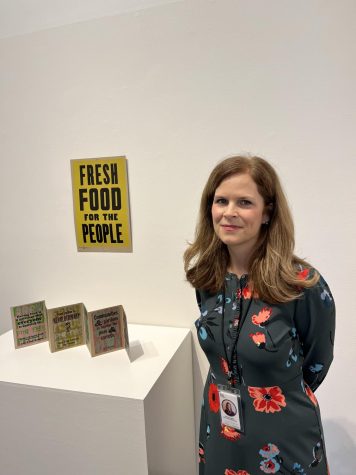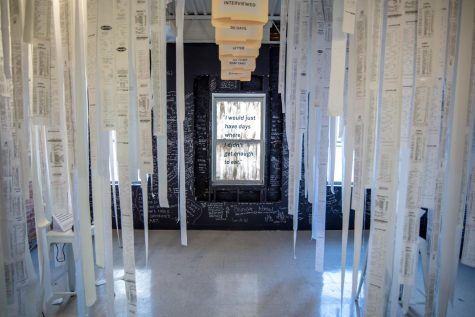Amid the inevitable deluge of overindulgent Thanksgiving-themed feasts, Instagram stories and Facebook posts rises an interesting question: what about the families who don’t have access to food?
The latest leg of the traveling exhibition “Food Justice: Growing a Healthier Community through Art” debuted its opening reception at the Fuller Craft Museum in Brockton, MA on Nov. 12. Based in craft tradition, the social justice project—which is on loan from the Contemporary Craft Museum in Pittsburgh—features 19 unique outside-the-canvas installations that raise awareness on structural classism, corporate agriculture, and food waste. The exhibit will be on display until next April. Admission is free.
Fuller Craft Museum’s artistic director and chief curator, Beth McLaughlin, explained how museums invite people to engage in critical issues through artwork.
“Craft is uniquely positioned to address these issues because the works in the gallery are made with materials that are so tactile and so familiar to us—it lowers the entry point even more and it makes the issues more accessible,” McLaughlin said.
Traditional art museums often place fine arts on a pedestal, which creates a disconnect between the audience and the canvas. But as an artistic medium, a craft installation that integrates everyday arts and crafts materials functions as a dialectic: making an abstract problem like food injustice tangible enough for conversation.
“I think it’s just really about setting up the gallery so that people can understand the different messages that the artists were trying to convey,” McLaughlin said. “Maybe by placing [the crafts] in [relation] to other objects, new connections can be made.”

Beth McLaughlin, Head Curator and Artistic director, next to Free Food for the People by Amos Kennedy.
Artist Jeff Schmuki’s installation, titled “Community Hydroponic Garden,” features a vegetable garden built on recycled sawhorses. Schmuki built hydroponic gardens across his local community to cultivate awareness on corporate agricultural practices. In doing so, he hopes to empower people to grow their own food—anybody can do it. The food will be harvested and donated to local organizations.
“Why are we trucking a salad 3,000 miles from where we are? Can’t we grow a salad here?” Schmuki said. “That’s one of the reasons food is so expensive. Locally-based production will lower the cost of food and benefit the environment.”
Schmuki’s wife Wendy DesChene engineered a pair of remote-controlled plant robots that guests can drive around the exhibit. The couple want audiences to start asking questions about where their food comes from. When we know less and less about how our food is made, we start to lose control of what we eat.
“You wouldn’t expect to see a garden inside a craft museum, but there’s something disruptive about putting a garden in the Fuller Craft,” DesChene said. “The plant bots that run around the gallery are also disruptive and that disruption is all a vehicle to create dialectic art, which is conversation.”
Graphic print artist Amos Paul Kennedy Jr. says people have stigmatized the act of growing vegetables in your backyard.
“I think [growing your own food] is considered rural, and it’s a sign of poverty more than affluence,” Kennedy said. “Poor people grew their own food. Farmers grew their own food because they just didn’t have the infrastructure you have now for processed foods.”
Kennedy’s piece, “Fresh Food for the People,” prints the titular mantra in bold capital letters on recycled materials with a letterpress. “The People” associates with marginalized communities who have been dismissed as a technicality inside the world of fine print. The artwork is a direct challenge to the status quo that excludes people of color, “the People”—both in publishing and in food security.
“There’s a reason why there aren’t as many grocery stores in marginalized communities,” McLaughlin said. “There is structural racism at play preventing nation-wide food access.”
Kennedy says food insecurity is the world’s dumbest problem.
Especially in urban areas where it can be difficult to buy fresh and affordable food, the subsequent food desert is not a naturally occurring phenomenon—rather, it is intentional. It’s reductive when we “solve” the systemic issues preventing food equity with charity. In art, these topics reflect the affected communities who demand intersectional, long-term justice.
“It’s not as if we’re not making enough food or not farming enough food, [the problem] is distribution issues,” Schmuki said. “How do we get unused food that’s going bad to the people who need it?”
Artists Mollie Ruskin and Xena Ni tell the story of thousands who seek help to pay for food access in “Transaction Denied”—a collage of food stamp receipts, manila folders, and audio testimonies of human struggle amidst systemic failures.

Transaction Denied by Mollie Ruskin and Xena Ni
“[Mollie and Xena] wanted people to understand that so many individuals are literally living hand to mouth, and there’s a stigma around people that are using government assistance for food,” McLaughlin said.
Topographic artist Stefanie Herr identifies a disconnect between the food we eat and where it comes from in the way food is marketed to consumers. Herr’s installation “Alcampo x Butcher Bob’s Garden,” includes topographic photo prints of packaged meats and farm animals. Nowadays, food has been reduced to a capitalist aesthetic, meats in particular are portrayed in a way that separates the consumer from the animal of origin.
“[Food] becomes something super abstract,” Herr said. “We have Mortadelo shaped like teddy bears and cheese shaped like Mickey Mouse. It’s sanitized. The kids who see this want to have a fun shaped meal so they don’t consider the alternative. It’s seductive imagery.”
Amidst dinosaur chicken nuggets and frozen meatballs, grocery stores cater to an audience who care less and less about the quality of their food. Americans are so far removed from the process of sourcing, preparing, and appreciating food—efforts to grow vegetables or start a conversation all help consumers reclaim the narrative we’ve lost.
Food can be so much more.
For mixed media artists Gavin Benjamin and Jason Forck, food history is identity. In his installation “Passages,” which features a wide-length photograph of comfort foods from the artist’s childhoods inlaid on a black background. Benjamin considers how he can preserve his family’s food traditions by cooking his mother’s rum cake and pepper pot soup from her kitchen in Queens, NY. Food always asks something of responsibility: how we choose to involve ourselves in the process can either be liberating or oppressive.
“[The exhibit is] also about understanding food like salted cod had a big role in sustaining enslaved peoples and the slave ships coming into this country,” McLaughlin said. “For that reason, [Benjamin] won’t eat salted cod.”
The act of eating underscores a power that we consumers have: choice. When big industries keep the food-making process hidden from consumers, it compromises our ability to make informed decisions about what we eat.
“If you’re a kid and you grow up with this idea that your meat is a meatball or something like that, you don’t actually know it’s an animal,” Herr said. “How can you even be conscious about what you are eating? It’s all too easy how food is preserved in an abstract way within the industry and we just consume it.”
Caring about where our food comes from is a big ask. But food security is one of the biggest indicators of community health.
“As a curator, I would say I’ve really understood that the work that we do at Fuller Craft Museum can impact our direct community,” McLaughlin said. “The exhibition itself is just the beginning, [it is] the spark that can create so much greater change.”